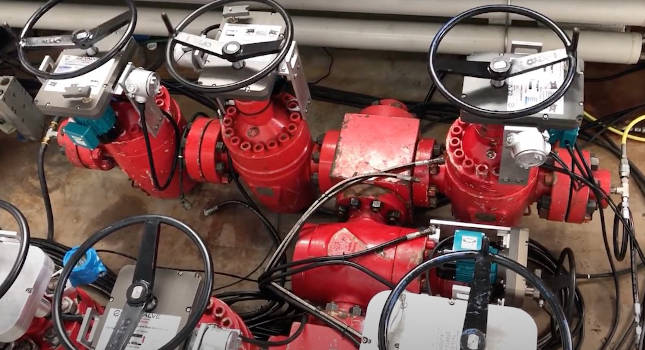An oil and gas original equipment manufacturer (OEM) uses edge computing for integrated data and control to maintain the safety and integrity of drilling facilities.

Learning Objectives
- Edge controls can give users seamless operation and better data access.
- Oil and gas companies depend on a constant stream of data to avoid downtime due to equipment breakages and malfunctions.
- Security is maintained through a point-to-point virtual private network (VPN).
Engenuity Inc. provides control automation and data integration solutions across several industries, with a primary focus on advanced technologies for the oil and gas industry. For many of customers, hydrostatic pressure testing of blowout preventers and well control equipment must be completed every few weeks to validate and maintain the safety and integrity of drilling facilities. These tests are typically executed and recorded manually, taking hours to complete. According to Engenuity, it can cost as much as $6 per second to operate the associated valve arrays in an offshore drilling application. Testing may cost users millions of dollars annually.
Engenuity developed a set of fully automated test execution and reporting products after collaborating with Shell International Exploration and Production Co., and others. Automated test execution and reporting combines precise process control, automatic text and email notification, and process history storage and replication into one solution using edge programmable industrial controllers (EPICs).
Pressure comparison, analytics, actuator, controls
Using testing software, users can map out valve arrays and identify validation pressure limits for each component in the system. This brings the system to pressure while precisely measuring the injected fluid and objectively comparing measurements against validation criteria using a patented constant-pressure/variable-volume pumping method.
With a retrofittable actuator, the test manager can monitor and control as many as 70 valves through up to 30 test sequences. The vision readout used an acoustical leak detection system to pinpoint the location of leaks in large-manifold systems. Collected data can be mapped between tests for comparison and reliability purposes and used to generate .PDF reports.
System architecture for modeling, analytics
BOPX offers sophisticated modeling, analytics and presentation functions. While Engenuity has added many features over the years, Ted Royer, a controls engineer with Engenuity, said, “All the test software is on the EPIC. BOPX is just an interface now.”
Cybersecurity: Manufacturing DMZ, trusted network
The software’s primary role in test execution is to send configuration data to the edge controller over a Modbus/TCP connection.
“We could do other things, but we needed a way to show where the data was,” Royer said, to meet customer needs.
Engenuity found that customers want to work with traditional protocols so they can verify configuration parameters are transmitted correctly without too much trouble.

However, an unsecured Modbus connection could pose a risk to operations, so Engenuity used the configurable firewall to protect critical control data. One of the controller’s two network ports is configured as a read-only interface joined to an untrusted network named the manufacturing demilitarized zone (DMZ). The other network port is joined to a separate, trusted network, named the Manufacturing Zone, where all input/output (I/O) and control communication takes place. The controller prevents routing traffic between its two ports, so there is no risk of untrusted connections tampering with configuration, execution, or process history data on the trusted network.
Process control, alarm notification
With configuration data securely transmitted, the edge controller’s real-time control engine begins executing test scenarios. Automated valve manifolds and connections are often integrated directly into the local I/O modules, but if a large amount of high-speed processing is required (typically in the 3 to 4 ms range) the company uses a separate edge controller as a remote I/O. In that case, the remote EPIC handles the control independently and reports back to the primary edge controller.
As test execution proceeds, the primary controller monitors the process. “We have a really well-developed alarm system we‘ve developed over decades,” Royer said. “It runs in the controller, not the HMI, so it’s available to other systems.” This includes external mail and messaging services, which the control program contacts to generate notifications for a range of conditions.
Process history storage
The primary controller also stores any process data generated during testing to an internal database server. Using a secure shell (SSH) interface to the edge controller’s operating system (OS), Engenuity downloads and installs this open-source software using a cryptographically-signed package supplied by the vendor. Signed applications prevent the introduction of malware posing as legitimate software.
To transfer data from the control engine to the database, Engenuity uses an open-source Internet of Things (IoT) engine, which is pre-installed on the edge controller by the vendor. It provides thousands of functions for connecting and processing data from different sources, including devices, databases, and web services. Engenuity configures the engine to monitor I/O, process variables, and events, then transmit these data points to the internal database server.

Data integrity, availability
Because testing data is used to validate the safety and efficacy of the user’s system, customers need frequent access to process history and often require additional protections to ensure data integrity. It’s done with the database’s built-in replication function.
“Typically, on an oil rig, customers just have a Wi-Fi connection to the equipment, which isn’t super reliable,” Royer said, “and they want to be able to log in and see data from previous runs. Sometimes they want to pull massive amounts of records, even entire jobs, into an [Microsoft] Excel spreadsheet… It doesn’t have to be real-time, though, so we will set up another controller here in the office that serves as a replica for the one that’s in the field.”
Periodically, the database server housed in the on-shore replica controller requests data replication from the off-shore primary controller. In response, the primary database server sends a transaction log to the replica, which it uses to update itself. Instead of burdening the primary controller with large data requests, customers can connect to the replica, providing them with data redundancy and high availability. “We have plenty of bandwidth here [in the office],” Royer said, “so it gives them the best of both worlds.”
Transmitting sensitive data between networks over long distances creates security concerns. To facilitate secure data exchange with the primary edge controller, Engenuity joins the replica controller to the off-shore Manufacturing Zone network over a point-to-point virtual private network (VPN) connection. Engenuity grants customers read-only credentials to this private network. To make the arrangement as “simple and bulletproof” as possible, Royer said, every replica controller in his company’s offices connect to the outside through a separate, dedicated VPN appliance.
If a customer wants to distribute process data beyond one site, they can add cloud injection capabilities to the replica controller using its embedded connectivity software. The platform’s modular architecture allows Engenuity to install a range of components, which allow the controller to send OPC tag data directly to cloud services. Once there, customers can access testing data around the world.

Benefits of edge control: Money, time, space, uptime
For many customers, testing is required for regulatory compliance, and the cost of downtime may be anywhere from $15,000 to $20,000 per hour. BOPX must execute quickly and reliably to deliver value. Depending on an installation’s size and operations, Engenuity’s BOPX testing system can save 10-20 hours for each full test with a fully integrated system. With high uptime and automated testing, the company’s customers can reduce on-site staff and have adapted more easily to remote operations.
“There are so many advantages to having a full control system that can tell you what’s wrong,” Royer said. “I’ll get a text [from the control system] in the middle of the night, and I’m already logged in by the time [the customer] calls me…. I can tell them exactly where the problem is, and, usually, it’s something simple.”
With traditional PLCs, Royer said, Engenuity’s solution would require ongoing support from IT, but with edge controllers, they are able to manage the entire solution themselves.
“[Users] don’t have space for racks of servers…. These [IT rooms] are non-classified areas in the middle of hazardous areas. They are designed to be half full and [typically] they are overfull…. So now you are going to replace that with stuff that can go outside in a NEMA 4 box… [Our EPIC’s] got 9 servers on it and we haven’t even taken up 1 foot of space,” Royer said.
With edge control, Engenuity has eliminated complex multiproduct integration requirements and delivers seamless operation and instant data access.
Jeff Hilpert, president at Engenuity, said, “The integration of data and control on a single backplane has been key to dramatically lowering cost, improving uptime, accessing data, and expanding utilization.”
Josh Eastburn, director of technical marketing, Opto 22. Edited by Chris Vavra, web content manager, Control Engineering, CFE Media and Technology, [email protected].
MORE ANSWERS
Keywords: edge computing, remote monitoring, edge controls
ONLINE
Learn more about Engenuity at https://www.engenuityinc.com.
CONSIDER THIS
What benefits could edge controls provide to your company?
